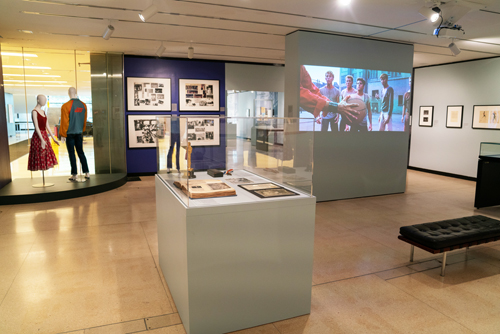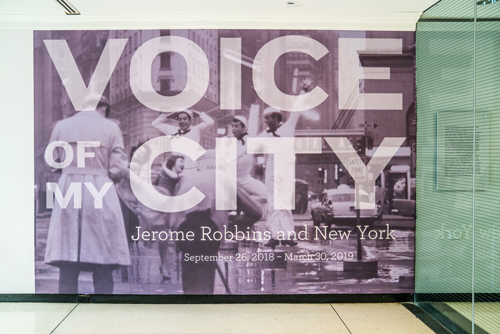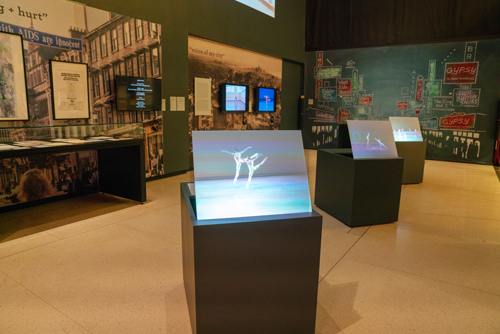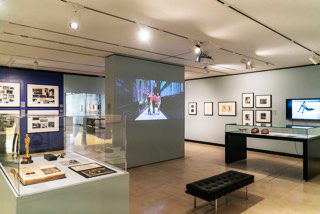Dance: Voice Of My City ~Jerome Robbins, New York and The Dance Collection
By Dawn Lille
arttimesjournal April 6, 2019
 From the exhibit Voice Of My City Jerome Robbins, New York and The Dance Collection (photo: Jonathan Blanc) |
Jerome Robbins (1919 - 1998), regarded by many as THE greatest American choreographer, was multi-talented. He was a dancer, choreographer, director, photographer, writer and graphic artist. A vulnerable, insecure perfectionist with a need to be accepted, he also explored thoroughly and interpreted broadly New York, the city in which he was born and lived his entire adult life. The exhibition "Voice of My City Jerome Robbins and New York" at the New York Library for the Performing Arts (Lincoln Center) was a thoughtfully researched and beautifully presented window into his work and its relationship to the city that inspired him. The noteworthy curator was Julia Foulkes .
His poetic images, seen in large print at the entrance, mad e one think of Whitman or Sandburg:
My city lies between two rivers ….. My beautiful city … is tall
and
jagged … honey combed with worm tunnels … chokes on its own
breath …. Is a lone man walking at night down an empty street
watching his shadow grow longer.
The first movement one saw upon entering was an enlarged home movie of a young Robbins dancing on a rooftop with his mother. The numerous other films show him performing, working with and coaching dancers, including Michail Baryshnikov, and a section of his ballet "New York: Opus Jazz," filmed after his death on a section of what became the High Line. These and everything else in the exhibit were flanked by meticulously researched signage based on material in the Dance Collection.
 From the exhibit Voice Of My City Jerome Robbins, New York and The Dance Collection (photo: Jonathan Blanc) |
Examples of the carefully detailed scenarios Robbins wrote for ballets he might create (some of which came to fruition) could detain the viewer for hours. His sketches and drawings are serious works of art. His notebooks and diaries, often illustrated, reveal both an acute observer and an excellent writer. Most amazing was the section of accordion pleated, colorfully illustrated diaries displayed in two vitrines that resembled Japanese scrolls. All reflected on his life, his friends, his many self doubts and included theater stubs, photos and newspaper clippings,
Robbins' dance creations covered both Broadway and the classical ballet stage. "West Side Story," one of his eleven musicals, which resulted in his Oscar for the movie version, was shown in the exhibit. Quintessentially NYC, it was a joint venture between Robbins and Leonard Bernstein, who had first worked together on the ballet "Fancy Free." They both intuitively understood the essence of America and New York and were perfect artistic collaborators.
In a filmed interview Robbins compares creating a ballet to building a bridge; it is a self contained and satisfying structure. To him, ballet was a space containing the drama of how people move in it, just like his city.
Robbins became interested in recording and archiving dance and developed a fervent desire to preserve it. He even experimented with film on his own. He gave his archives to the Dance Collection and in 1965 gave it one per cent of his royalties from "Fiddler On The Roof." It is now known as The Jerome Robbins Dance Collection.
 From the exhibit Voice Of My City Jerome Robbins, New York and The Dance Collection (photo: Jonathan Blanc) |
In addition to the exhibition and the Robbins centennial celebration, the Jerome Robbins Dance Collection presented an evening honoring the five women who have served as its curators: Genevieve Oswald, Madeleine Nichols, Michelle Potter, Jan Schmidt and Linda Murray. It was called "An Eternal Footprint: The Dance Division at 75."
Oswald was a music librarian who was given the additional job of creating and maintaining a small dance collection consisting of 5 lithographs, 150 photos, 175 books, 100 folders and 10 clippings files, all in a cubicle office in a public library.
A determined and formidable force, she tracked down dancers living at the time (Ted Shawn, Jose Limon, students of Isadora Duncan) and went door-to-door collecting information and obtaining archives. Unable to attend the evening, she was heard in an early interview with the dance critic Walter Terry and she died in mid- March at the age of 97.
Madeleine Nichols succeeded Oswald as curator. She had been the librarian in charge of drawings and film and returned after a ten- year hiatus, during which she studied and practiced law. Nichols was particularly interested in bringing together the library and the community - a mission she gracefully accomplished.
Michelle Potter, a dance historian from Australia, was fascinated by posters and photographs and recalled being thrilled to discover photographs of Balinese dance taken by Henri Cartier- Bresson. The library started to make forays into the new technology during her tenure..
 From the exhibit Voice Of My City Jerome Robbins, New York and The Dance Collection (photo: Jonathan Blanc) |
Jan Schmidt, with her chuckling sense of humor and her focused determination to get through a pile of work, was in charge of film and video. When she became curator she wanted to find rare material in the collection and make it accessible to all. She shared an early example of Baryshnikov in a ballet competition and one of a very young Suzanne Farrell dancing with George Balanchine.
Linda Murray, tall, blond and Irish ("She doesn't look like a librarian" someone near me whispered) is the current curator, fascinated by the "hidden" items she still discovers. A painting by the artist and Diaghilev cohort Natalia Goncharova is an example. Murray is building on the work of her predecessors, using technology and reaching out to different audiences and artists.
This is the greatest dance collection in the world, free and open to everyone. It has unbelievable material for dancers, scholars, choreographers, designers, musicians and the general public. It also offers exhibitions and programs, free and open to all. Put the Jerome Robbins Dance Collection on your list.
dawnlille@aol.com
